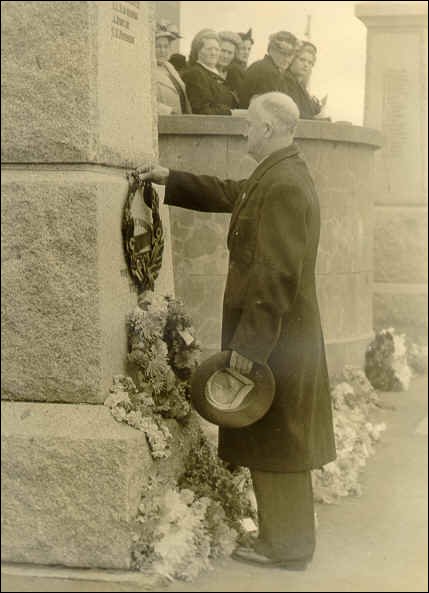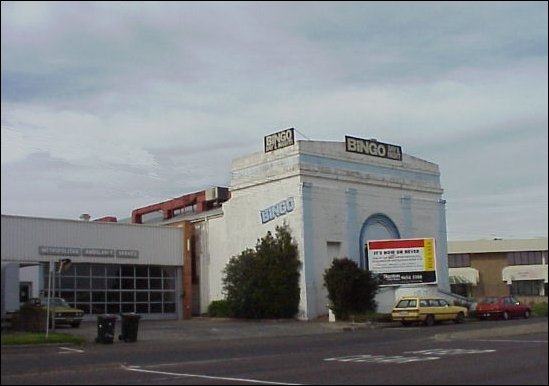The Protestant Hall: Still Standing
The Cheltenham Protestant Hall Company Limited came into being on May 26, 1886 when a capital of £2,000 was being asked through the sale of 2,000 shares, but the Protestant Alliance Friendly Society members were so anxious to buy these shares that a meeting finally decided to call up only 1,000 of them when it was seen that the cost of the hall would be within the range of £900.

The ‘Protestant Hall’ on Nepean Highway, Cheltenham, c1943.
Thus began the history of the impressive white building that still stands alongside the Cheltenham Ambulance Station on Nepean Highway between Southland Shopping Centre and Chesterville Road. This hall was first opened towards the end of 1886 after seven prominent citizens had signed the following petition to the Chief Secretary’s Office on June 4 of the same year.
"We the several persons whose names and addresses are subscribed are desirous of being formed into a Company in pursuance of this Memorandum of Association and we respectively agree to take the number of shares in the capital of the Company set opposite our respective names.
Harold Sparks, Auctioneer, Market Buildings, Melbourne 50 shares Charles Hearle, Estate Agent, Chancery Lane, Melbourne 5 shares Thomas Bent, MLA, Landcox Brighton 10 shares
George Keys, Rate Collector South Brighton 10 shares
Henry McCurry Market Gardener Cheltenham 10 shares
Edward Logg, Draper, 9 Barret Street East Melbourne 10 shares
Lewis Guy Cali Market Gardener, Charman Road, Cheltenham 5 shares
Witness to the signatures of all the above subscribers
(signed) Stuart D Craig
Clerk to Trick & Best
Solicitors, Melbourne
The objects for which the Company was established were numerous, as was clearly detailed under the "Companies Statute 1864" and outlined in a Memorandum of Association of the Cheltenham Protestant Hall Company Limited. The name of the Company was to be "THE CHELTENHAM PROTESTANT HALL COMPANY LIMITED".
The Registered Office was to be "situated in the City of Melbourne or at such place in the Colony of Victoria as may be determined on "while the main objects for which the Company was established were as follows -
"To purchase rent take on lease or otherwise acquire any land building or property in the Township of Cheltenham and elsewhere in the Colony of Victoria and to build and erect on such land a hall or halls club house or club houses with appurtenant buildings already erected upon any such land for the purpose of converting the same or portion thereof into a hall or halls club house or club houses with appurtenant buildings and premises and to fit up furnish and supply such hall or halls club house or club houses as a Protestant Hall of halls or a club house or club houses and also all appurtenant buildings and premises with furniture and all necessary adjuncts."
In a word, the seven backers of the Protestant Hall were not only intent on building a hall in Cheltenham, but were enthusiastic enough to (should the opportunity present itself) build a number of halls in Cheltenham or anywhere else in the State of Victoria, and while this was not to eventuate, the Protestant Hall for the first 50 years of its existence served as something of an associate meeting, social, display, entertainment and education centre to its horizontal weatherboard styled Mechanics Institute counterpart, on the site of the present Cheltenham Hall and Library.
Next to the Protestant Hall was a shed like structure where the Cheltenham Rangers unit of the Victorian Rangers Division met and at times fought mock battles against the Brighton Rangers whose Commander would give orders to that unit to ‘seize’ both the main building and the adjacent one. By October 1899, however, a number of the Brighton and Cheltenham Rangers were on their way with the first Victorian troops to be despatched to the South African War to engage in real battle. Fittingly, upon their return a gat-lit lamp, a drinking fountain and a memorial column with the names of those who took part in the war inscribed on the column, was erected 100 yards or so from the hall from which they had been farewelled. The memorial now (minus the drinking fountain and gas lamp) has been moved with the two major war monuments, from the Nepean Highway to the site of the former asphalt tennis court in Cheltenham Park in the interest of road-widening.

The South African War Memorial on its original site on the corner of Point Nepean and Chesterville Roads, Cheltenham.
The Protestant Hall during the past 91 years has filled many of the needs of both Moorabbin and Cheltenham and during the 1890s, members of the Moorabbin Shire Council discussed the possibility of purchasing the building and transferring the Council’s whole business to that site and using it as the Town Hall. Sandringham and Mordialloc, which were then part of the Moorabbin Shire, were both calling for severance and Councillors from the ridings which covered both areas ridiculed the fact that an inland rural body had so much to say over their bayside beach localities. Cr Edward Penny who lived at his farm on Bay Road Cheltenham, insisted that the reason for the ‘cry for severance’ was that the Town Hall was too far into the northern end of the district and that it should be transferred to Cheltenham. He gained the support of Cr George Brownfield who lived in Mordialloc, and the two of them began to call on other Councillors to assist them in having the Town Hall re-sited in a more central position at Cheltenham.
Alfred Born of Sandringham who was keen to see the severance take place, when approached, however, took another view altogether; he said Cheltenham people would be given an opportunity to join the proposed Sandringham Council but was challenged by Cr Robert Mills of Heatherton who claimed that Cheltenham residents would prefer to become part of Mordialloc.
As it then appeared that Cheltenham would leave Moorabbin to join one proposed council or the other, any chance of gaining a town hall to take with it began to fade rapidly. Thomas Bent, in the meantime, began to plead with the discontented Councillors to ‘keep the shire intact’ and that was how things remained until eight years after his death. Sandringham severed its ties in 1917, and Mentone and Mordialloc in 1921, while Cheltenham continued as part of the parent shire, which finally decided to purchase the Protestant Hall after all, not as a municipal building, but for use by the Returned Soldiers and Sailors League, in whose hands it remained until the late 1970s when it was taken over by a catering firm after the RSL moved into new quarters.
The Hall in earlier times served as the Sunday School for the Methodist Home for Children (built 1892) until the Home could afford to build its own chapel, and as a schoolhouse when the Beaumaris School (now Cheltenham State School) No 84 later met with overcrowding problems. It was also a popular venue for annual balls and regular dances held by church groups and sporting organisations. During the 1920s, and right up to the late 1950s, the building became recognised as Cheltenham’s only picture theatre where in the beginning only silent films could be seen; but the "Soldiers Hall" as it was then known, moved with the times into screening black and white talkies that later moved into colour. During the war years, newsreel films from the European and Middle East theatres of war arrived in Australia within a matter of weeks of battles being fought, causing members of the families with sons or brothers on active service to make their Saturday night visit to the ‘pictures’ a regular excursion. Films aimed at boosting the morale of the general public followed the newsreels with a gentle theme of propaganda that well served its purpose.
Perhaps the best remembered activity at the old building was the ANZAC Day Ceremony which was first held in the entrance-way (where the Nepean Highway serviced lane now crosses) in the early 1920s, and repeated each year afterwards for over half a century; progress alone, in the coming of the multi-laned highway and new service lanes however limited the tenure of the service being conducted at the old venue.

Wally Rose placing wreath on memorial outside the Soldiers Hall, Cheltenham c1945.
Ironically, the ‘Soldiers Hall’ which had such a reputation as a picture theatre presented Cheltenham (in 1956) with its first public television viewing. ‘Boxes’ were placed at regular intervals around the room and the general public packed the building to see the new ‘marvel’ which quite unexpectedly would become powerful enough to lift the hall’s theatre life right out of business. Again modern times were catching up exactly as they did when the fire station next to the hall was changed almost overnight to an ambulance station and the retarded boys farm gave way to Southland.

The hall, July 1999.
Footnotes
- First published in mooroobin Volume 2 No 6 1981.
